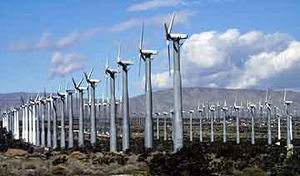Climate Crisis advocates doggedly promote wind and solar power as alternatives to petroleum and coal-based energy sources. Solar power has serious fundamental problems inherent to its nature, specifically its intermittency and grid-destabilization. Wind turbines bring even more problems, having the same intermittency and grid-destabilization issues, while causing even more environmental damage than solar panels. Some problems are unique to the inherent nature of the turbines.
As with solar panels, wind turbines, including their blades, are made by energy-intensive processes. They also incorporate many materials that are, in turn, mined – using machinery, fuel and processes that environmentalists generally condemn. The Manhattan Institute notes “…building a single 100-MW wind farm— never mind thousands of them—requires some 30,000 tons of iron ore and 50,000 tons of concrete, as well as 900 tons of non-recyclable plastics for the huge blades.”
Onshore wind ‘farms’ bring arrays of dozens of wind turbines, dominating large swathes of land. The potential areas impacted are of orders of magnitude greater than the base area of turbines’ towers, encompassing expanded safety zones. Hannah Ritchie, of Oxford Martin Programme of Global Development, has calculated the average land use for onshore wind farm projects globally at about ninety-nine square metres per MW of power capacity – this about one hundred hectares per one GW facility serving about 700,000 people. Nuclear and gas-fired power plants need much less land: three or thirteen hectares each, respectively.
Turbine blades are deadly to birds and bats, including endangered species. John Merriman, the Bird-Smart Wind Energy Campaign Director at the American Bird Conservancy, calculates annual U.S. turbine-caused deaths of birds alone exceed one million. This includes collisions or electrocutions via dedicated power lines connecting turbines to the grid. In one meta-analysis, the bat fatality rate was three times that of birds. U.S. wind capacity was 1,075 MW in 2022, while global capacity is 837 GW. If U.S. bird and bat fatality numbers are proportionate worldwide, a staggering 779 million birds and over two billion bats could be being killed annually.
Whales are also vulnerable. Preliminary seafloor surveying work for wind turbines often involves sonic waves, which disorient whales, causing them to ground themselves and die. Pile driving prior to building turbine foundations harms even more. Whales have been found dead in numbers far exceeding the normal fatality levels before sonic surveying began.
Other serious wind turbine problems are mechanical unreliability and their unsafeness. One blade flew off a turbine offshore Massachusetts this year, disintegrating upon landing. According to CNN.com, this has occurred in Germany, Sweden, Lithuania and the U.K. in recent years. Further to their unreliable nature, dependence on erratic wind energy had caused a deadly freeze in Texas and power outages in Europe in the summer of 2021.
A final and damning factor for wind turbines should be the current non-recyclability of their fiberglass-and-epoxy blades. Some promising recycling methods are being developed, but the blades’ immense size (up to 107 m) make them innately difficult to transport and handle.
Wind turbines are far less safe and durable than solar panels, and they can cause even more environmental damage. Wind turbines are also unreliable, relatively short-lived, and, as an energy-storage-lacking additional input to the electrical grid, unavoidably destabilize it. For these reasons, wind turbines should be avoided.
Ian Madsen is the Senior Policy Analyst at the Frontier Centre for Public Policy.



